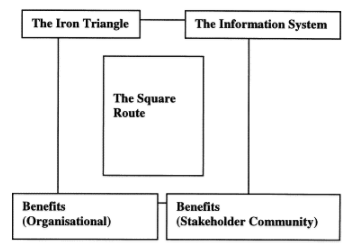Limitations of the iron triangle
Time, cost and quality (TCQ) form the iron triangle. The iron triangle has been a major tool in measuring project management “success” during the last 50 years.
Despite the fact that it is such a common tool, Roger Atkinson, amongst many other academics and practitioners, discusses its limitations to measure project management success.
First, there has been an almost infinite number of project failures from the stakeholders’ point of view applying these three constraints as measurement objectives equal to the project successes, however, these projects has been a project managmenet success. Projects have to be measured on a broader perspective because TCQ are limited by only measuring success by budget, schedule and a certain required quality. Atkinson speaks for a comprehensive measurement i.e. do sponsors like it, do customers use it and has it improved efficiency and effectiveness? In line with that he outlines, that cost and time can be on track, thus there is progress but it isn’t automatically success for instance it doesn’t measure customer satisfaction.
Another basic problem with the TCQ is that they are estimated at a point in the project where their values are in fact guesses due to the limited information at this particular phase. He calls it an error that other success criteria than the iron triangle don’t appear as measurement for success.
A new measurement system will take stakeholders satisfaction and post implementation criterions into account. Muller and Judgev are aligned with the measurement issue that project management is mostly addressing phases until project termination but not the post implementation phase resulting in a limited success picture of the specific project.
According to Atkinson, there is a distinguish between errors divided into two certain sort of errors Type I and Type II. Type I errors are when something is done wrong while Type II errors are when something isn’t as good as it could be or something is missing. The iron triangle is categorized as a Type II error. The Type II error pictures the limitations of the iron triangle that it does measure project objectives, nevertheless, other objectives are needed to measure project success.
Muller and Judgev further define project success to be measured against all objectives of the project and emphasize inclusion of stakeholders while the iron triangle measure project management success, not project success. For example, the Sydney Opera House was a project management failure 14 times over budget and it took 15 years to build. However, the engineering, architectural and society results and benefits are indisputable successful.
A new model extending the measurement system of projects is the square route model by Atkinson. The iron triangle plays a role but three other success criteria complement it. The information system is technical strength of the resultant system coming from the project, (direct) benefits to the organization and (indirect) benefits to the stakeholder community. All of the three will be measured in the post implementation phase after project completion.
Annotated Bibliography
Muller, R. and Judgev, K., 2005
In their paper, they engage widely with development of success criteria during 40 years of project management. They come around program and portfolio management as well giving a profound idea of what it is. One subject they delve into is the intangible versus tangible objectives which projects and project managements are measured against. To get a better understanding of measuring success this article is a good choice to read because it seems that success doesn’t only come down to time, cost, quality and scope.
Atkinson, R., 1999
This article focus specifically on the limitations of the iron triangle, that time, cost and quality can’t be the only parameters for project success. It especially outlines that the limit of the iron triangle is in fact lacking of extensive objectives taking post implementing phase into account. Well exemplified by the Type II error. For getting an even better understanding of what is behind the Type II error and square route to measure success a look on this article can be recommended.
